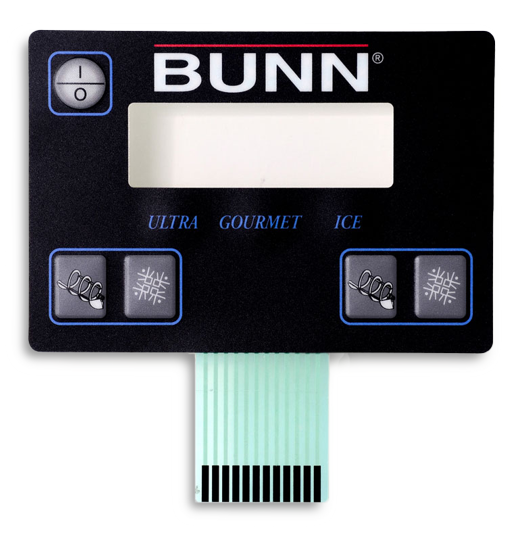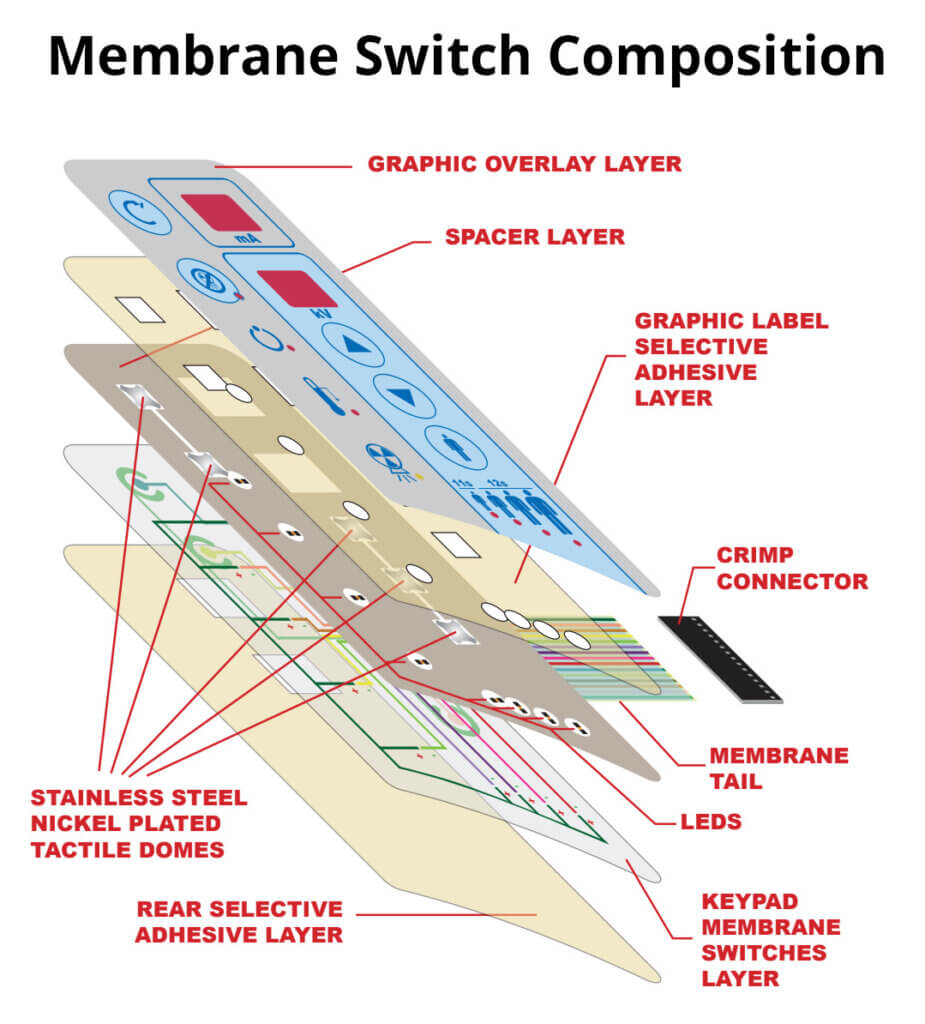Work with a Membrane Switch Manufacturer Focused on Quality
Work with a Membrane Switch Manufacturer Focused on Quality
Blog Article
Understanding the Relevance of Membrane Switch in Modern Electronics and Their Applications
Membrane switches over act as a crucial element in modern-day electronic devices, supplying a reliable user interface for individual interaction. Their light-weight and adjustable nature makes them appropriate for a variety of applications across varied industries. Understanding their essential parts and benefits can provide understandings right into their expanding significance. As innovation proceeds to advancement, the evolution of Membrane switches questions regarding their future applications and style developments. What lies ahead in this dynamic area?

What Are Membrane Switches?
Membrane switches are vital elements in modern electronic devices, working as interface that assist in communication in between individuals and tools. These switches are composed of numerous layers, including a graphic overlay, a sticky layer, and a circuit layer, every one of which work with each other to produce a practical and durable user interface. The design permits a flat, inconspicuous solution that can be customized concerning dimension, form, and visual look, making them appropriate for numerous applications, from consumer electronic devices to clinical tools. The responsive responses supplied by Membrane switches over boosts user experience, while their resistance to dirt and wetness makes them suitable for challenging environments. Membrane buttons can include attributes such as backlighting and published graphics, additionally expanding their use. Their versatility and robustness make them a preferred option in industries where integrity and ease of usage are extremely important, ultimately adding to the seamless procedure of modern-day electronic gadgets.
Secret Elements of Membrane Switches Over
While various parts add to the functionality of a membrane layer button, three primary layers play significant roles in its design and operation. The top layer, normally made from a long lasting polymer, serves as the interface for user interaction, often featuring printed graphics and icons. Beneath this is the spacer layer, which preserves the required range between the leading layer and the circuit layer. This spacer layer assurances that the switch activates only when pushed, protecting against unintended inputs. The circuit layer contains conductive traces that finish the electric circuit when the top layer is depressed. These traces can be made from numerous products, including copper or silver. With each other, these elements create a trustworthy and robust device that is portable and functional, appropriate for a variety of digital applications, from home appliances to clinical gadgets. Comprehending these crucial parts is important for appreciating the general functionality of Membrane switches.
Benefits of Using Membrane Switches

Membrane Switch Production Refine
Recognizing the Membrane switch production procedure reveals the complex steps associated with generating these necessary parts. The process typically starts with the layout phase, where formats and specifications are produced utilizing specialized software program. Following this, the visuals overlay is published on a flexible substratum, frequently utilizing high-resolution printing techniques to ensure clarity and precision.Next, the sticky layers are applied, which offer to bond the various elements with each other. The circuit layers, made from conductive inks or materials, are then published onto a different substrate. These layers are carefully aligned and laminated to produce a useful switch.After setting up, the switches undergo checking to validate performance and resilience. Quality control actions are implemented throughout the process to identify and correct any type of issues. Ultimately, the completed Membrane switches are packaged and gotten ready for circulation, all set to satisfy the needs of modern electronic applications.
Applications of Membrane Switches Over in Numerous Industries
Membrane buttons are increasingly made use of throughout numerous sectors, specifically in clinical devices and consumer electronics. In the medical area, they offer reputable control interfaces for devices that need accurate operation. In customer electronics, these switches boost individual interaction by offering streamlined and receptive user interfaces. Receptive Medical Devices Control
Various modern clinical tools make use of Membrane buttons for structured operation and boosted individual interaction. These buttons offer a reputable, resilient user interface for a variety of applications, consisting of diagnostic tools, person tracking systems, and medical tools. Their adjustable designs enable particular formats that can suit the unique requirements of healthcare specialists, making sure intuitive navigating and efficient accessibility to vital features. Furthermore, Membrane switches are immune to contaminants, making them appropriate for clean and sterile atmospheres. The responsive feedback they use can improve individual self-confidence, decreasing the threat of errors during essential medical procedures. see post On the whole, the integration of Membrane buttons in medical tools significantly adds to improved functional performance and patient security in medical care settings.
Consumer Electronics Interfaces
In the domain name of customer electronics, Membrane switches play a critical role in improving customer interfaces throughout a large range of gadgets. These buttons are indispensable to products such as remote controls, microwaves, and gaming consoles, supplying additional reading a efficient and user-friendly interface. Their style permits a smooth combination of graphics and performance, allowing makers to develop smooth, modern-day aesthetic appeals without endangering usability. Membrane switches are likewise understood for their toughness, usually withstanding substantial use and direct exposure to numerous environmental conditions. Additionally, they can incorporate attributes like backlighting and responsive comments, additional boosting the customer experience. As consumer demands for innovative yet intuitive user interfaces expand, Membrane changes continue to be a vital element beforehand electronic device functionality.
Layout Factors To Consider for Membrane Changes
Designing reliable Membrane switches requires careful focus to different elements that affect both performance and customer experience. One crucial consideration is the selection of products, as they can impact durability, responsive comments, and aesthetic charm. Choosing a suitable adhesive is important for assuring long-lasting bond and resistance to environmental factors.In enhancement, the design and layout of the switch must fit user communication, with switch dimensions and spacing optimized for convenience of use. The unification of graphics and labeling ought to focus on clarity and presence under various lights conditions.Consideration of electrical features, such as actuation pressure and button sensitivity, will certainly enhance the responsiveness of the Membrane button. The style needs to accommodate producing processes to guarantee cost-effectiveness and timely manufacturing. Generally, a well-thought-out layout boosts both the performance and the customer experience of Membrane buttons in modern-day electronics.

Future Fads in Membrane Switch Technology
As innovation remains to progress, Membrane buttons are positioned to incorporate brand-new advancements that will enhance their performance and application in different areas. One significant trend is the consolidation of versatile and long lasting products, which will certainly boost the life-span and integrity of these switches. Enhanced surface textures and customizable graphics are likewise prepared for, enabling even more intuitive user interfaces.Moreover, the combination of wise innovation, such as touch-sensitive surfaces and haptic feedback, is expected to boost customer communication, making Membrane changes a lot more appealing and responsive. Additionally, advances in published electronic devices will make it possible for more complex circuitry within thinner accounts, additionally broadening design possibilities.Sustainability will certainly also play an important duty in future growths, as makers check out environmentally friendly materials and manufacturing processes. Overall, these fads will assure that Membrane switches continue to be appropriate and vital in an interconnected and progressively electronic world.
Regularly Asked Concerns
Just How Do Membrane Switches Over Compare to Traditional Mechanical Buttons?
Membrane changes deal advantages over typical mechanical buttons, including reduced dimension, lighter weight, and improved longevity. They usually give a sealed surface area, enhancing resistance to dust and moisture, making them ideal for diverse applications.
What Products Are Frequently Utilized in Membrane Switch Building?

Can Membrane Switches Over Withstand Extreme Environmental Issues?
Membrane switches can withstand extreme ecological conditions, depending upon their layout and materials. High-grade constructions usually feature toughness against temperature level fluctuations, humidity, and direct exposure to chemicals, making them ideal for various demanding applications across sectors.
The Length Of Time Do Membrane Switches Over Commonly Last Prior To Failure?
Membrane switches usually show a lifespan ranging from 1 to 10 million actuations, depending upon variables such as use frequency, environmental conditions, and manufacturing top quality. Routine upkeep can expand their durability and operational reliability significantly.
Are Membrane Changes Personalized for Details Applications?
Membrane switches are indeed customizable for particular applications. They can be tailored in dimension, performance, and style, allowing manufacturers to fulfill unique user requirements and enhance item visual appeals while maintaining operational performance and longevity. Membrane switches are vital elements in modern electronic devices, offering as customer interfaces that promote interaction between gadgets and individuals. The tactile responses supplied by Membrane switches boosts individual experience, while their resistance to dirt and wetness makes them optimal for challenging settings. The consolidation of graphics over here and labeling ought to prioritize quality and exposure under various lights conditions.Consideration of electrical characteristics, such as actuation pressure and switch sensitivity, will improve the responsiveness of the Membrane button. Enhanced surface area structures and customizable graphics are likewise anticipated, permitting for more instinctive individual interfaces.Moreover, the integration of wise technology, such as touch-sensitive surface areas and haptic feedback, is anticipated to improve customer interaction, making Membrane switches a lot more engaging and responsive. Membrane switches deal advantages over standard mechanical buttons, including minimized dimension, lighter weight, and improved longevity.
Report this page